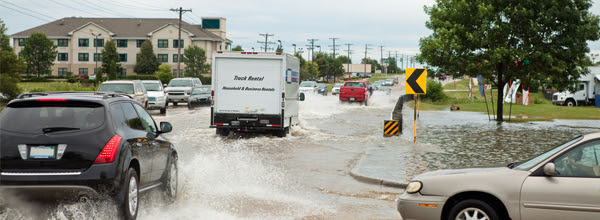Train Your Driving Staff for Rainy, Slippery Conditions
When it’s the rainy time of year, companies with driving employees and/or fleets need to double down on road safety.
That means holding a training session on driving in the rain. While it may seem redundant, it’s an important exercise to reinforce the importance of being extra careful when the roads are wet, particularly if it has not rained for some time.
In this article we will cover some safe driving tips for your drivers from Bayview Insurance Services to help you minimize the risk of auto accidents in adverse weather conditions.
Some Key Statistics
One-quarter of speeding-related large truck accident fatalities happen in rainy or other poor weather conditions, according to the Federal Motor Carrier Safety Administration.
On an annual basis, adverse weather conditions lead to:
-early 4,900 fatal car accidents
-Over 301,000 injury car accidents
-Nearly 919,000 PDO (property damage only) car accidents
Training your driving employees takes planning, and there are some essentials that you should cover in your safety meetings and materials. You should break up the training into two parts:
Five things to do before you drive
- Check the forecast — When it’s that time of year, train your driving employees to check the weather forecast before their shift so they know what they are in for. While they should be comfortable driving in rainy conditions, they should pay particular attention when there are heavy downpours and the chances of flooding increase. Another risk is if it rained the night before and then the temperatures dipped below zero, creating icy roads.
- Plan ahead — On rainy days, drivers should check Department of Transportation maps for possible road closures due to flooding or severe weather so they can plan alternative routes.
- Check truck and trailer — Regardless of the weather, drivers should always inspect their equipment prior to starting their day to ensure everything is in safe and good working order. Check tires as well. They should be properly inflated to their recommended amounts.
- Dress for the weather — If drivers are heading into a stormy and cold weather area, they should make sure to bring proper attire for the conditions, like a jacket or rain parka. It’s also recommended that they carry water and food in case they are stranded.
- Let drivers decide — The final decision on whether to head out in rough conditions should be left to the driver. If they do not feel comfortable about heading out, urge them to report this to their manager or supervisor.
Driving in wet conditions
- When the storm clouds set in, drivers should turn on their headlights. While it may not improve their vision during the daytime, it does make the truck more visible to other motorists and pedestrians.
- In adverse conditions, drivers should keep their radios on stations that air regular weather updates.
- When driving in the rain, drivers should accelerate and decelerate slowly and gradually. Pressing on the accelerator too quickly can cause the truck to lose traction. The same goes for applying the brakes too hard.
- If there has been flooding and some roadways are submerged or have large puddles covering the street, drivers should not attempt to drive through them. It’s hard to gauge how deep the water is and the road underneath may have been washed out. If they encounter this, the safe thing to do is stop and turn around.
- In wet conditions, drivers should drive slower than the posted speed limit — at least 5 miles an hour slower in the rain and even slower if they encounter heavy traffic, curves or have a light trailer, which may not get as much traction as a loaded truck.
- Besides driving more slowly, drivers need to increase the following distance between the truck and vehicles ahead. Safety experts recommend seven seconds following distance for large trucks in good conditions. They recommend increasing it when it’s raining, and even more if it’s hard rain or stormy.
- Drivers should avoid using cruise control as it’s harder to detect that the vehicle is hydroplaning. Also, they should avoid using the engine brake in the rain.
- If drivers hit really bad weather and do not feel comfortable continuing, you should urge them to get off the road and park somewhere safe. They should avoid parking on the side of the road as visibility may be poor. They should inform headquarters where they have parked, and again when they feel it’s safe to proceed.
The takeaway
Ideally, you should incorporate rainy-day driving training at least twice a year for your driving staff to refresh their safety awareness. Weather is becoming more unpredictable and when it rains after long dry spells, roads can be especially perilous.
